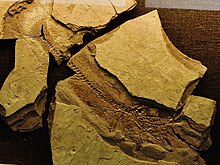Palimphyes
Appearance
| Palimphyes Temporal range:
| |
|---|---|

| |
| Fossil of Palimphyes at the Bürgermeister-Müller-Museum | |
| Scientific classification | |
| Domain: | Eukaryota |
| Kingdom: | Animalia |
| Phylum: | Chordata |
| Class: | Actinopterygii |
| Order: | Scombriformes |
| Family: | †Euzaphlegidae |
| Subfamily: | †Dipterichthyinae Arambourg, 1967 |
| Genus: | †Palimphyes Agassiz, 1835 |
| Type species | |
| †Clupea elongata de Blainville, 1818
| |
| Species | |
|
See text | |
| Synonyms | |
| |
Palimphyes is an extinct genus of marine ray-finned fish known from the Paleogene period. It was a euzaphlegid, an extinct family of scombroid fish related to the escolars and snake mackerels.[1]
Taxonomy
[edit]
The various species lived as deepwater mesopelagic predators throughout the Tethys and Paratethys oceans, with fossils of ten species found in earliest Eocene to Oligocene strata of the Swiss Alps, the Carpathian and Caucasus Mountains, Iran, India, and Turkmenistan.
The following species are known:[2][3]
- P. chadumicus Daniltshenko, 1960 - early Oligocene (Rupelian) of the North Caucasus, Russia (Pshekha Formation) (=P. longirostratus Daniltshenko, 1980)[4]
- P. elongatus (de Blainville, 1818) (type species) - Rupelian of Canton Glarus, Switzerland (Glarner Schiefer Formation)
- P. lanceolatus (Simionescu, 1904) - Rupelian of Romania (=Krambergeria Simionescu, 1904)[5][6]
- P. leptosomus (Arambourg, 1967) - Middle/Late Eocene (?Priabonian)[7] of Iran (Pabdeh Formation) (=Dipterichthys leptosomus Arambourg, 1967)
- P. misrai Sahni & Choudhary, 1972 - early Eocene (Ypresian) of Rajasthan, India (Kapurdi Formation)[8]
- ?P. nematophorus (Arambourg, 1967) - ?Priabonian of Iran (Pabdeh Formation) (=Dipterichthys nematophorus Arambourg, 1967)
- P. originis (Ciobanu, 1976) - Rupelian of Romania (=Dipterichthys originis Ciobanu, 1976)[6][9]
- P. palaeocenicus Daniltshenko, 1968 - earliest Eocene (Ypresian)[7] of Turkmenistan (Danata Formation)
- P. pinnatus Daniltshenko, 1962 - middle Eocene (Lutetian) of Georgia (Dabakhan Formation)[4]
- P. pshekhaensis Bannikov, 1993 - middle Eocene (Bartonian) of Krasnodar Krai, Russia (Kuma Formation)[4][9]
- P. stolyarovi Bratishko & Udovychenko, 2013 - Rupelian of Kazakhstan (Uzunbas Formation) & Crimea (Kyzyl-Dzhar Beds) [otolith][10]
Indeterminate species are also known from the early Oligocene-aged Menilite Formation of Poland and the Czech Republic.[6][11]
See also
[edit]References
[edit]- ^ Bannikov, ALEXANDRE F. "A new genus and species of putative euzaphlegid fish from the Eocene of Bolca in northern Italy (Periformes, Trichiuroidea)." Studi e Ricerche sui giacimenti Terziari di Bolca, XII Miscellanea Paleontologica 9 (2008): 99-107. [1]
- ^ "PBDB Taxon". paleobiodb.org. Retrieved 2024-09-24.
- ^ Monsch, Kenneth A.; Bannikov, Alexandre F. (2011). "New taxonomic synopses and revision of the scombroid fishes (Scombroidei, Perciformes), including billfishes, from the Cenozoic of territories of the former USSR". Earth and Environmental Science Transactions of the Royal Society of Edinburgh. 102 (4): 253–300. doi:10.1017/S1755691011010085. ISSN 1755-6910.
- ^ a b c Банников, Александр Федорович (2009). "Ископаемые колючеперые рыбы (Acanthopterygii): систематика, филогения и роль в кайнозойских ихтиокомплексах Тетиса и Паратетиса". Палеонтология и стратиграфия (in Russian).
- ^ Danilʹchenko, P. G. (1967). Bony Fishes of the Maikop Deposits of the Caucasus: Kostistye Ryby Maĭkopskikh Otlozheniĭ Kavkaza. Israel Program for Scientific Translations [available from the U.S. Department of Commerce, Clearinghouse for Federal Scientific and Technical Information, Springfield, Va.]
- ^ a b c GREGOROVÁ, RŮŽENA (2012). "FOSSIL FISH FAUNA (TELEOSTEI, SELACHII) FROM THE DYNÓW MARLSTONE (RUPELIAN, NP 23) OF THE MENILITIC FORMATION AT THE LOCALITY OF LITENČICE (CZECH REPUBLIC)". Acta Mus. Moraviae, Sci. Geol. XCVI (2): 3–33.
- ^ a b Bannikov, A. F.; Erebakan, I. G. (2023-10-01). "On the Evolution of Some Groups of Marine Bony Fishes in the Cenozoic of the Tethys and Paratethys". Paleontological Journal. 57 (5): 475–490. doi:10.1134/S0031030123050015. ISSN 1555-6174.
- ^ Sahni, Ashok; Choudhary, Nagendra K. (1972). "Lower eocene fishes from barmer, South Western Rajasthan, India". Proceedings of the Indian National Science Academy - Part A: Physical Sciences. 38 (3–4): 97–102. ISSN 0370-0046.
- ^ a b "Палеонтологический журнал. Выпуск 2 (1993 г.) | Геологический портал GeoKniga". www.geokniga.org. Retrieved 2024-09-24.
- ^ Bratishko, A.; Udovychenko, M. (2013). "Fish otoliths from the Early Oligocene of Mangyshlak, Kazakhstan". N. Jb. Geol. Palaeont. Abh. 270 (2): 195–208. doi:10.1127/0077-7749/2013/0366.
- ^ Bieńkowska, M.; Wasiluk (2021). "The fish fauna of the Dynów Marl Member (Menilite Formation, Poland): paleoenvironment and paleobiogeography of the early Oligocene Paratethys". Bulletin of Geosciences. 96 (4). S2CID 247951943.
Categories:
- Prehistoric ray-finned fish genera
- Euzaphlegidae
- Paleogene fish of Europe
- Paleogene fish of Asia
- Ypresian genus first appearances
- Lutetian genera
- Bartonian genera
- Priabonian genera
- Rupelian genus extinctions
- Fossils of Switzerland
- Fossils of Poland
- Fossils of the Czech Republic
- Fossils of Romania
- Fossils of Ukraine
- Fossils of Russia
- Fossils of Georgia (country)
- Fossils of Kazakhstan
- Fossils of Turkmenistan
- Fossils of Iran
- Fossils of India
- Fossil taxa described in 1835
- Taxa named by Louis Agassiz
- Prehistoric bony fish stubs
